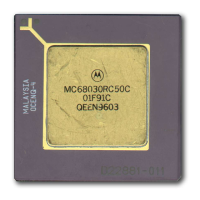Introduction
1-8
MC68030 USER’S MANUAL
MOTOROLA
Alternate function code registers, SFC and DFC, contain 3-bit function codes. Function
codes can be considered extensions of the 32-bit linear address that optionally provide as
many as eight 4-Gbyte address spaces. Function codes are automatically generated by the
processor to select address spaces for data and program at the user and supervisor
privilege levels and a CPU address space for processor functions (e.g., coprocessor
communications). Registers SFC and DFC are used by certain instructions to explicitly
specify the function codes for operations.
The cache control register (CACR) controls the on-chip instruction and data caches of the
MC68030. The cache address register (CAAR) stores an address for cache control
functions.
The CPU root pointer (CRP) contains a pointer to the root of the translation tree for the
currently executing task of the MC68030. This tree contains the mapping information for the
task's address space. When the MC68030 is configured to provide a separate address
space for supervisor routines, the supervisor root pointer (SRP) contains a pointer to the root
of the translation tree describing the supervisor's address space.
The translation control register (TC) consists of several fields that control address
translation. These fields enable and disable address translation, enable and disable the use
of SRP for the supervisor address space, and select or ignore the function codes in
translating addresses. Other fields define the size of memory pages, the number of address
bits used in translation, and the translation table structure.
The transparent translation registers, TT0 and TT1, can each specify separate blocks of
memory as directly accessible without address translation. Logical addresses in these areas
become the physical addresses for memory access. Function codes and the eight most
significant bits of the address can be used to define the area of memory and type of access;
either read, write, or both types of memory access can be directly mapped. The transparent
translation feature allows rapid movement of large blocks of data in memory or I/O space
without disturbing the context of the on-chip address translation cache or incurring delays
associated with translation table lookups. This feature is useful to graphics, controller, and
real-time applications.
Figure 1-4. Status Register
T1 T0 S M 0 I2 I1 I0 X N Z V C000
SYSTEM BYTE
USER BYTE
(CONDITION CODE REGISTER)
TRACE
ENABLE
INTERRUPT
PRIORITY MASK
SUPERVISOR/USER
STATE
MASTER/INTERRUPT
STATE
EXTEND
NEGATIVE
ZERO
OVERFLOW
CARRY
15 14 13 12 11 10 9 8 7 56 43210

